MDD Multi Delays Diffraction - home
Le casse acustiche MDD hanno una emissione del suono primaria e una serie di emissioni secondarie ritardate, coerenti e omnidirezionali distribuite nelle 3 dimensioni dello spazio. I fronti sonori delle emissioni secondarie sono specifici di ogni cassa acustica, ottimizzano l'interazione fra l'emissione primaria, le riflessioni dell'ambiente d'ascolto e le riflessioni registrate nel brano riprodotto. Parte dell'interazione con l'ambiente d'ascolto può essere gestita con la progettazione della cassa acustica.
MDD loudspeakers have a primary sound emission and a series of delayed, coherent and omnidirectional secondary emissions distributed in the 3 dimensions of space. The sound fronts of the secondary emissions are specific to each loudspeaker, they optimize the interaction between the primary emission, the reflections of the listening environment and the reflections recorded in the reproduced song. Part of the interaction with the listening environment can be managed with the design of the speaker.
Le casse acustiche convenzionali hanno solo l'emissione del suono primaria. La prima emissione è seguita da una serie di fronti sonori secondari generati dalle riflessioni degli oggetti nell'ambiente di ascolto. I fronti sonori secondari cambiano la qualità della riproduzione, possono alterare la risposta in frequenza o introdurre riverberi eccessivi. L'interazione con l'ambiente d'ascolto è gestita con il posizionamento della cassa acustica e con il trattamento acustico della stanza.
In uno specifico ambiente d'ascolto le casse acustiche MDD sono più facili da posizionare e hanno maggiori probabilità di funzionare correttamente.
Conventional speakers only have primary sound output. The first emission is followed by a series of secondary sound fronts generated by the reflections of objects in the listening environment. Secondary sound fronts change the quality of playback, can alter the frequency response or introduce excessive reverberation. The interaction with the listening environment is managed with the positioning of the speaker and the acoustic treatment of the room. In a specific listening environment MDD loudspeakers are easier to position and are more likely to function correctly.
Nelle casse acustiche MDD i carichi acustici sono guide d'onda multiple. Ogni guida d'onda fraziona l'energia sonora emessa del cono del driver, la isola dall'ambiente d'ascolto, la trasporta in posizioni distanti dal driver, la riemette con un ritardo e mantenendo la coerenza con l'emissione primaria del driver. Una guida d'onda spessa 2 cm con la diffrazione acustica genera fronti sonori di forma sferica fino a quasi 20 KHz. Con la tecnologia MDD si simulano sorgenti sonore tridimensionali, i ritardi ottimizzano l'ascolto in ambienti non trattati acusticamente, la diffrazione è omnidirezionale a tutte le frequenze.
In MDD loudspeakers the acoustic loads are multiple waveguides. Each waveguide fractions the sound energy emitted by the driver cone, isolates it from the listening environment, transports it to positions distant from the driver, re-emits it with a delay and maintaining coherence with the primary emission of the driver. A 2 cm thick waveguide with acoustic diffraction generates spherical sound fronts up to almost 20 KHz. With MDD technology, three-dimensional sound sources are simulated, the delays optimize listening in environments that are not acoustically treated, the diffraction is omnidirectional at all frequencies.
link - home
- MDD Multi Delays Diffraction
- mddOmni
- 3D effect
- anti Haas effect
- diffrattore acustico omnidirezionale - omnidirectional acoustic diffractor
- psicoacustica - psychoacoustics
- mddOmni diy
- mddTL
- cabinet neutro - neutral cabinet
- logarithmic sum
- mddTL diy
- supporto a risonanza subsonica - subsonic resonance support
- base asimmetrica - asymmetric base
- 3FE25
- stereo
componenti - components
Tre parti delle casse acustiche MDD sono: il carico acustico anteriore mddOmni, il carico acustico posteriore mddTL e la base con il supporto subsonico.
Three parts of the MDD loudspeakers are: the front acoustic load mddOmni, the rear acoustic load mddTL and the base with the subsonic support.
mddOmni
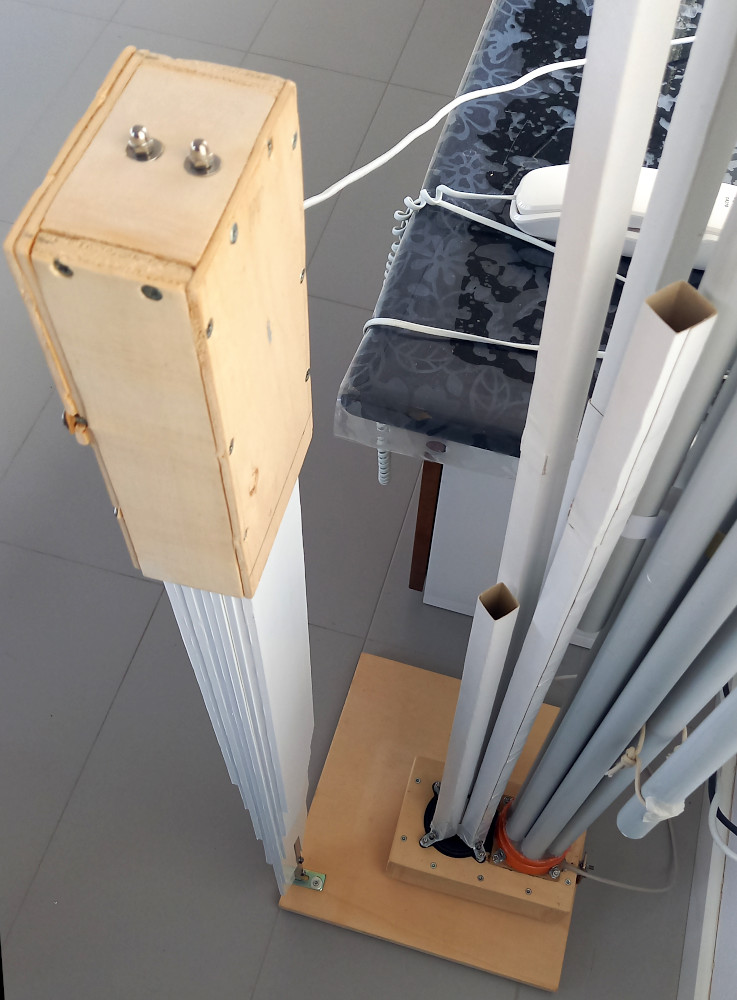
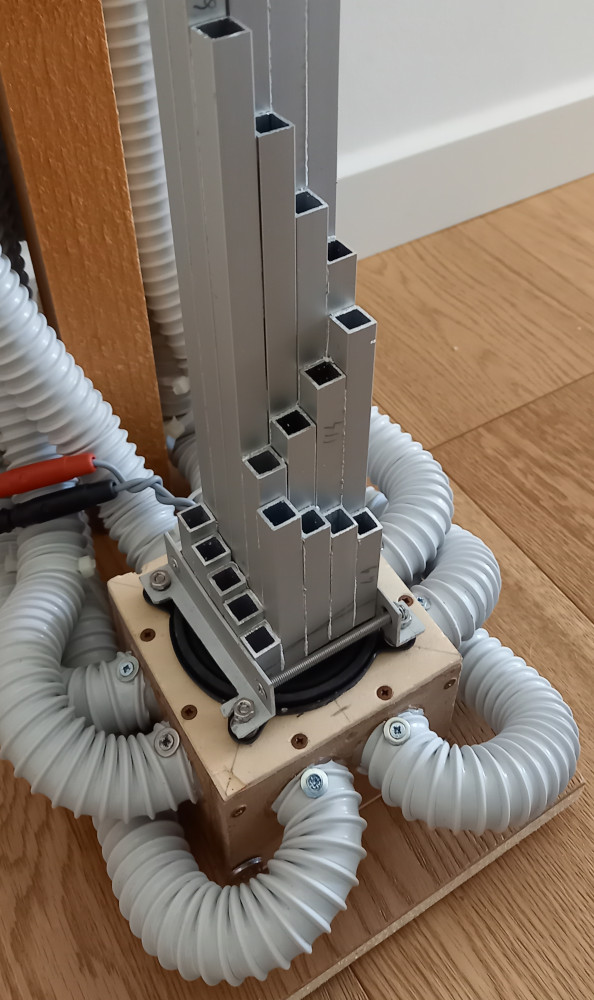 Il carico acustico frontale mddOmni ha serie di guide d'onda di lunghezza crescente posizionate di fronte al driver. In ogni guida entra una parte dell'energia acustica emessa dal cono del driver. La stessa energia è riemessa per diffrazione acustica, in posizioni diverse, con ritardi crescenti, con un fronti d'onda sferici e coerenti con l'emissione diretta del driver. Negli ultimi prototipi le guide sono aperte a entrambi i lati con risonanze a L/2. L'emissione direzionale del driver diventa omnidirezionale.
Il carico acustico frontale mddOmni ha serie di guide d'onda di lunghezza crescente posizionate di fronte al driver. In ogni guida entra una parte dell'energia acustica emessa dal cono del driver. La stessa energia è riemessa per diffrazione acustica, in posizioni diverse, con ritardi crescenti, con un fronti d'onda sferici e coerenti con l'emissione diretta del driver. Negli ultimi prototipi le guide sono aperte a entrambi i lati con risonanze a L/2. L'emissione direzionale del driver diventa omnidirezionale.
The mddOmni front acoustic load has sets of waveguides of increasing length positioned in front of the driver. A part of the acoustic energy emitted by the driver cone enters each guide. The same energy is re-emitted by acoustic diffraction, in different positions, with increasing delays, with spherical wave fronts and consistent with the direct emission of the driver. In the latest prototypes the guides are open on both sides with L/2 resonances. The driver's directional output becomes omnidirectional.
mddTL
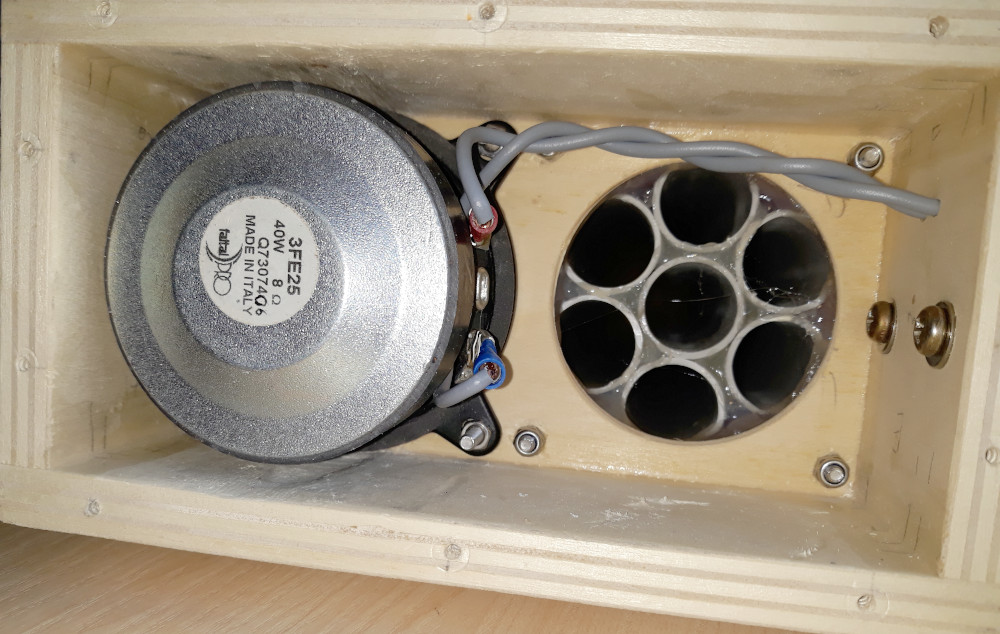
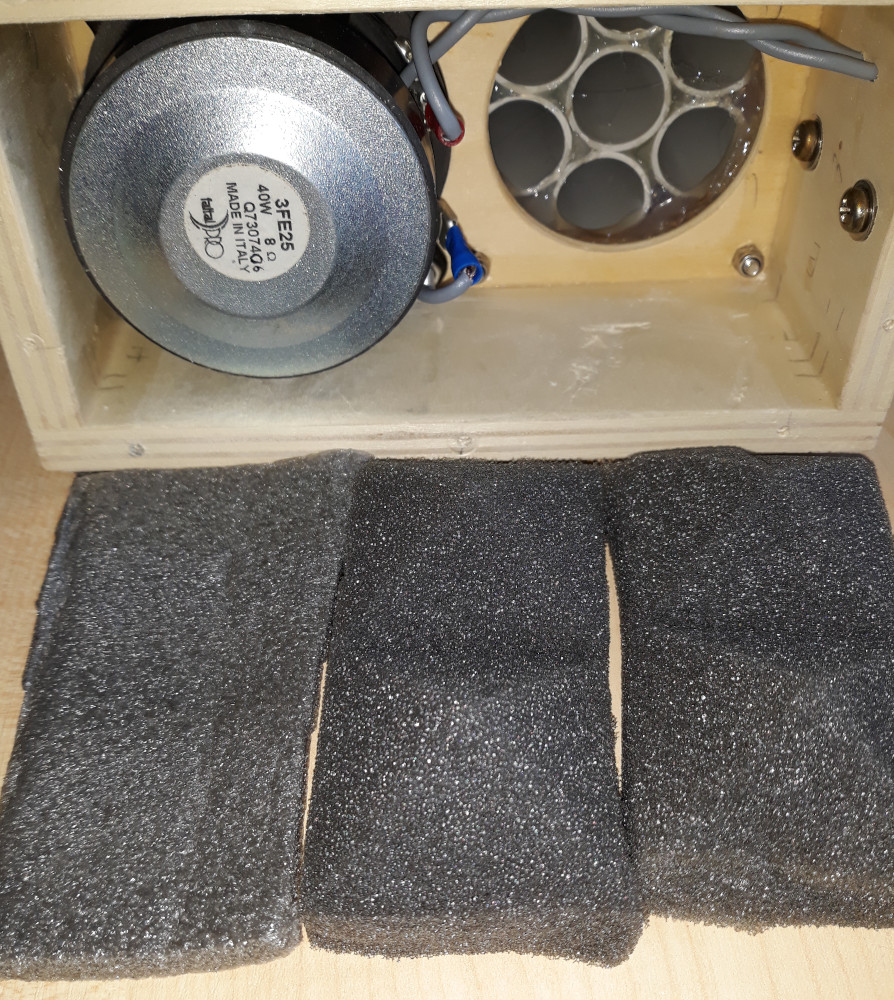
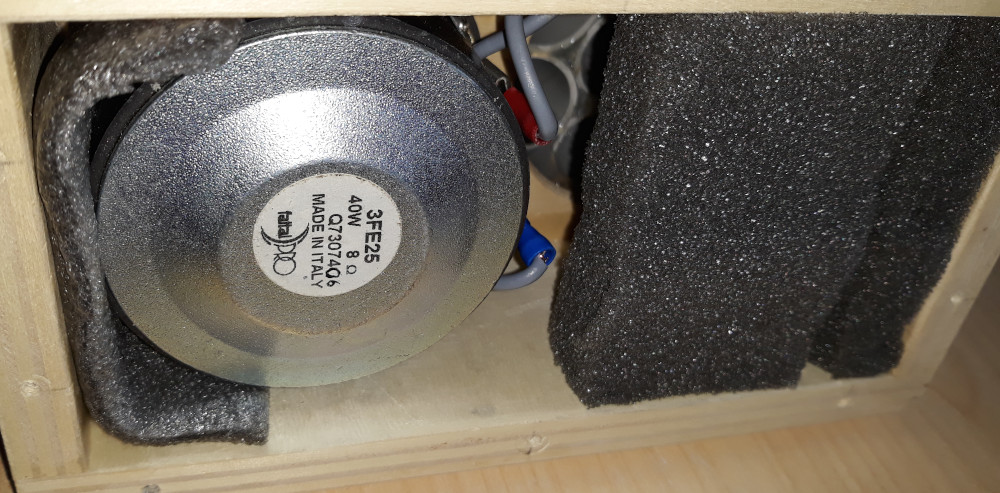 Il carico acustico posteriore mddTL ha guide d'onda multiple di lunghezza crescente fissate a una camera di compressione, è un insieme di linee di trasmissione con frequenze di risonanza L/4 e L/2. Alle basse frequenze il carico acustico mddTL è neutro rispetto ai driver e all'ambiente d'ascolto.
Il carico acustico posteriore mddTL ha guide d'onda multiple di lunghezza crescente fissate a una camera di compressione, è un insieme di linee di trasmissione con frequenze di risonanza L/4 e L/2. Alle basse frequenze il carico acustico mddTL è neutro rispetto ai driver e all'ambiente d'ascolto.
The rear acoustic load mddTL has multiple waveguides of increasing length attached to a compression chamber, it is a set of transmission lines with L/4 and L/2 resonant frequencies. At low frequencies the mddTL acoustic load is neutral with respect to the drivers and the listening environment.
supporto a risonanza subsonica con base asimmetrica
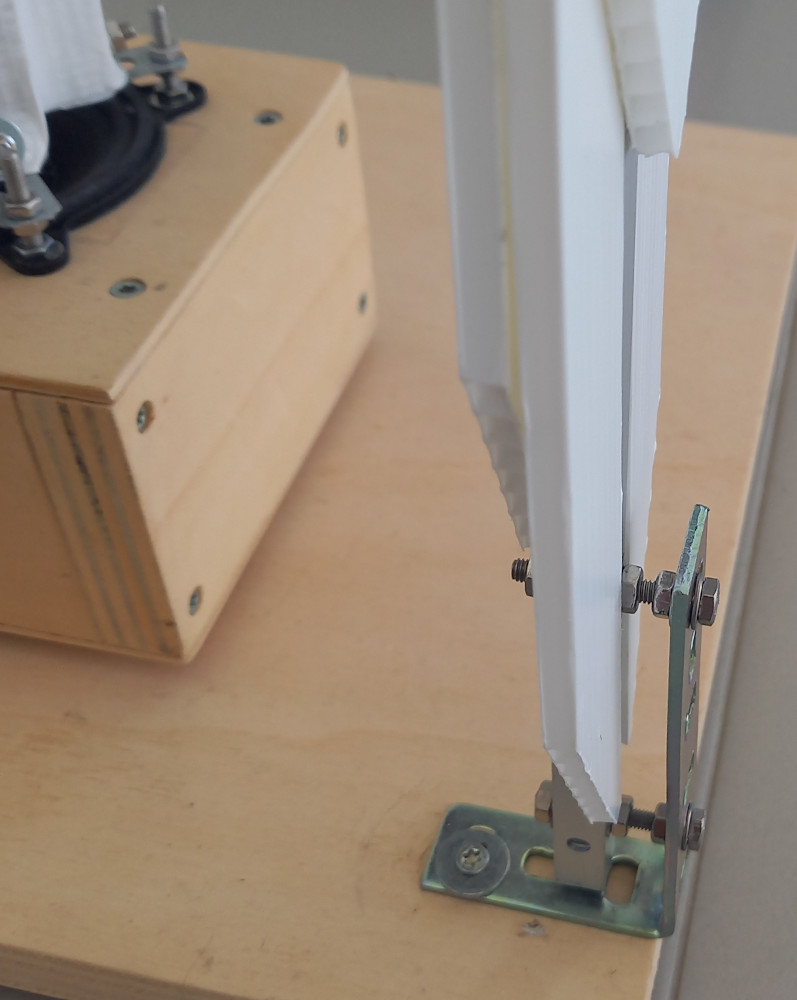
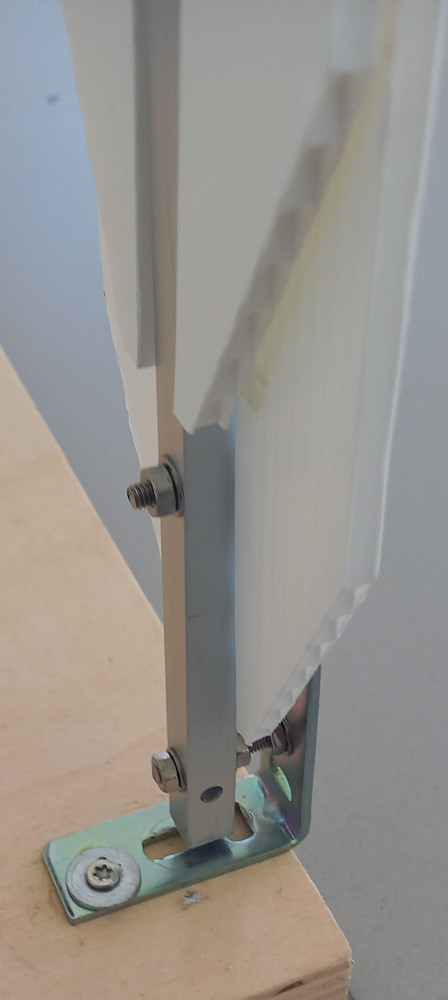
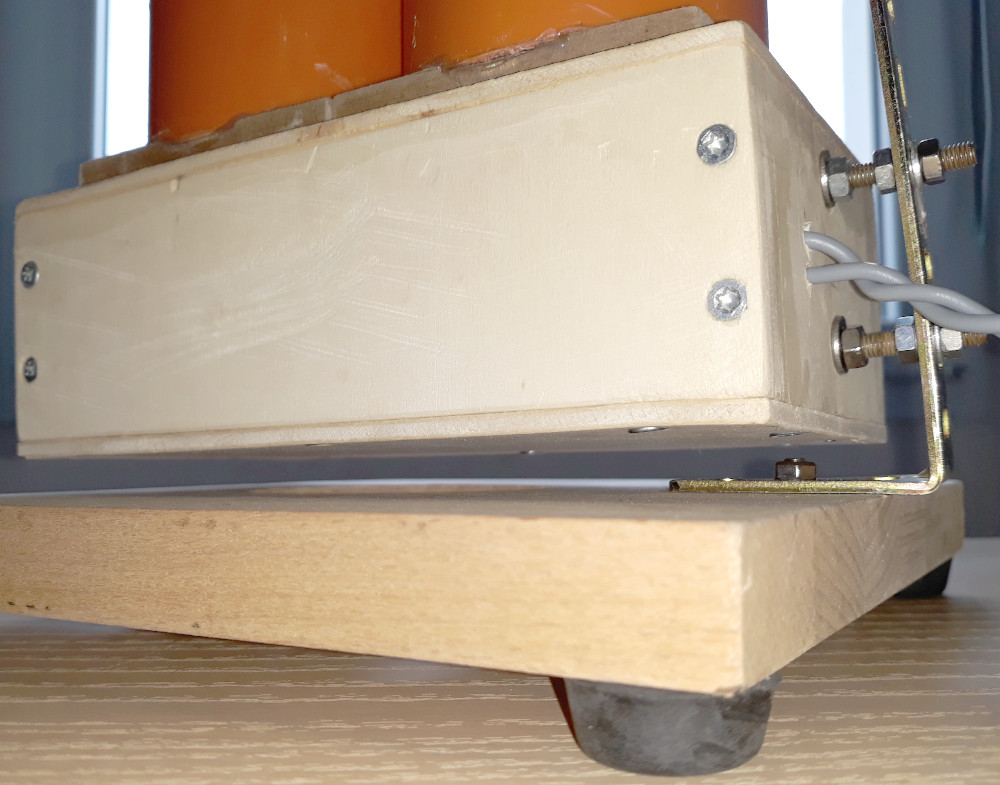
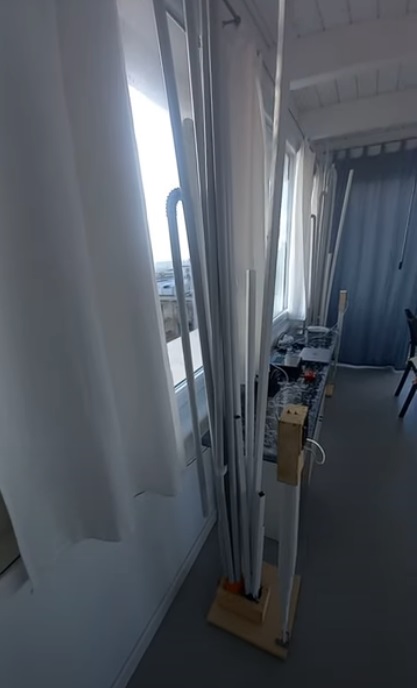 video
video
Il supporto a risonanza subsonica isola acusticamente l'altoparlante dal pavimento nella banda audio, migliora il dettaglio della riproduzione. La forma asimmetrica riduce l'innesco di vibrazioni spurie.
Subsonic resonance mount acoustically isolates the speaker from the floor in the audio band, improves reproduction detail. The asymmetric shape reduces the triggering of spurious vibrations.
caratteristiche audio - audio features
Caratteristiche delle casse acustiche MDD sono: immagine sonora 3D, anti Haas effect, emissione omnidirezionale, cabinet neutro, somma logaritmica.
Characteristics of the MDD loudspeakers are: 3D sound image, anti Haas effect, omnidirectional emission, neutral cabinet, logarithmic sum.
3D effect
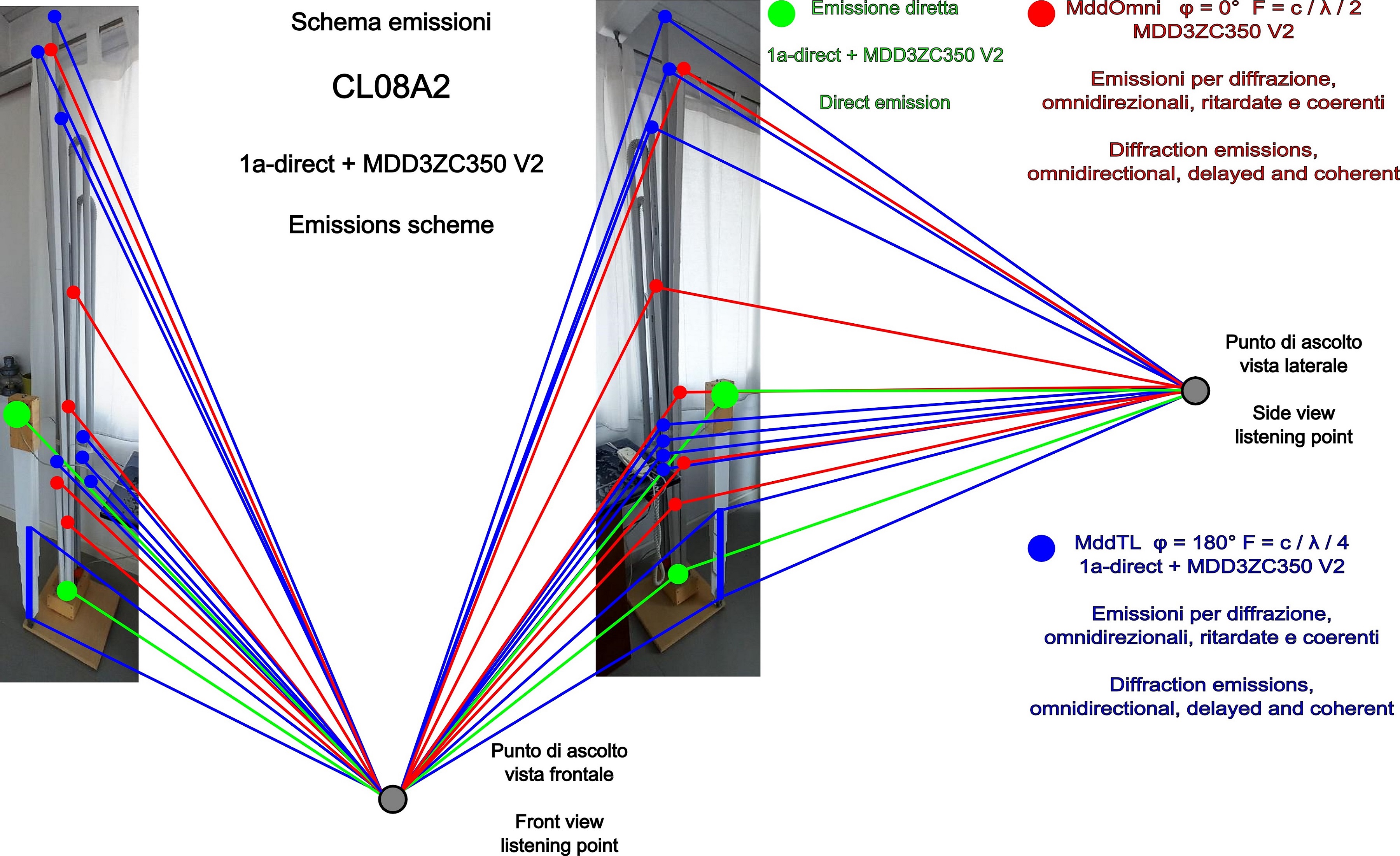 Le emissioni multiple simulano sorgenti sonore tridimensionali. Uno strumento emette suoni da più punti contemporaneamente, i punti di emissione multipli simulano lo strumento in 3D. Le casse acustiche MDD non sono in grado di ricreare la dimensione esatta dello strumento originale ma l'ascolto migliora rispetto alla riproduzione di una sorgente puntiforme.
Le emissioni multiple simulano sorgenti sonore tridimensionali. Uno strumento emette suoni da più punti contemporaneamente, i punti di emissione multipli simulano lo strumento in 3D. Le casse acustiche MDD non sono in grado di ricreare la dimensione esatta dello strumento originale ma l'ascolto migliora rispetto alla riproduzione di una sorgente puntiforme.
Multiple emissions simulate three-dimensional sound sources. An instrument emits sounds from multiple points at the same time, the multiple emission points simulate the instrument in 3D. MDD loudspeakers are not able to recreate the exact size of the original instrument but listening improves compared to the reproduction of a point source.
anti Haas effect
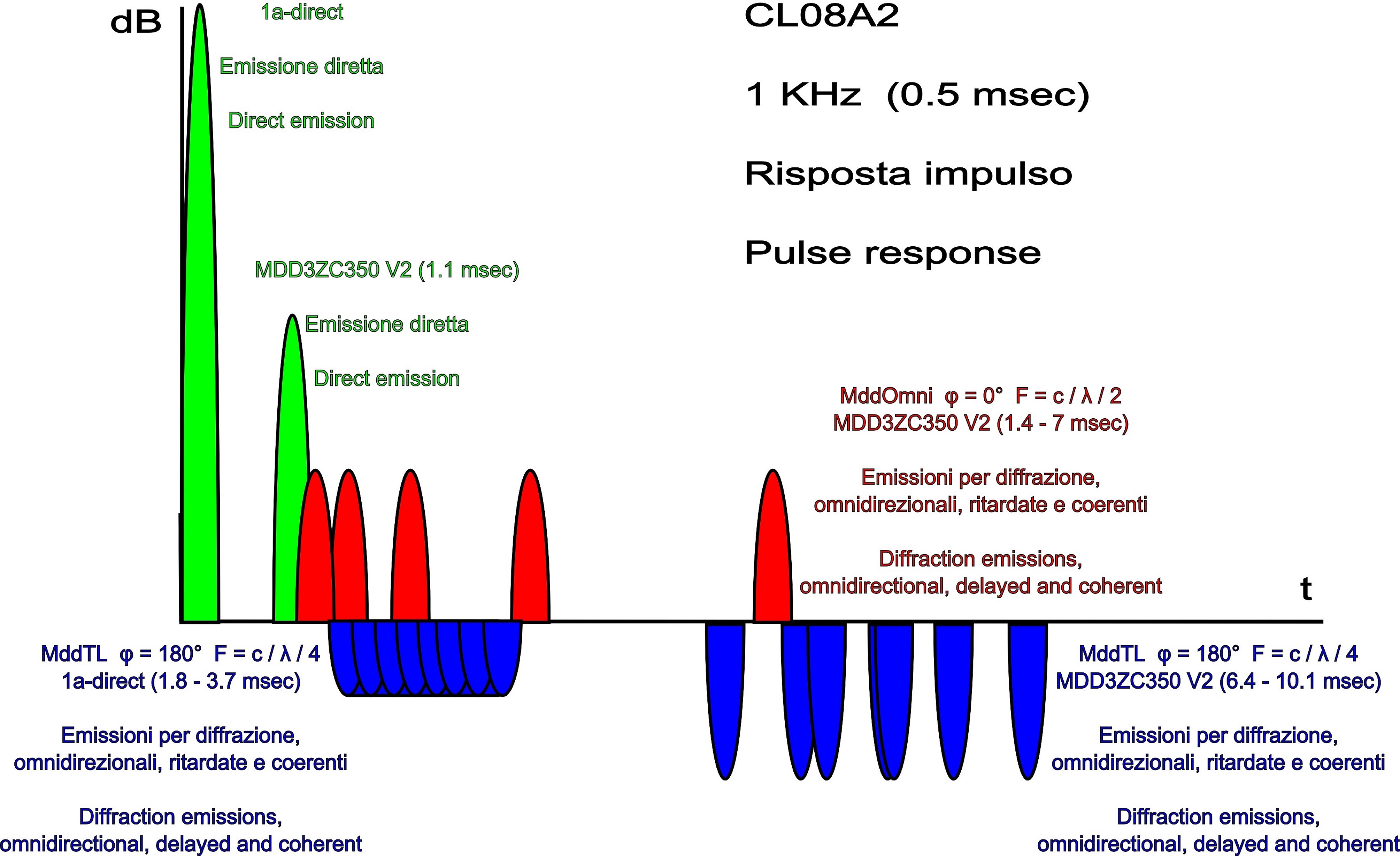
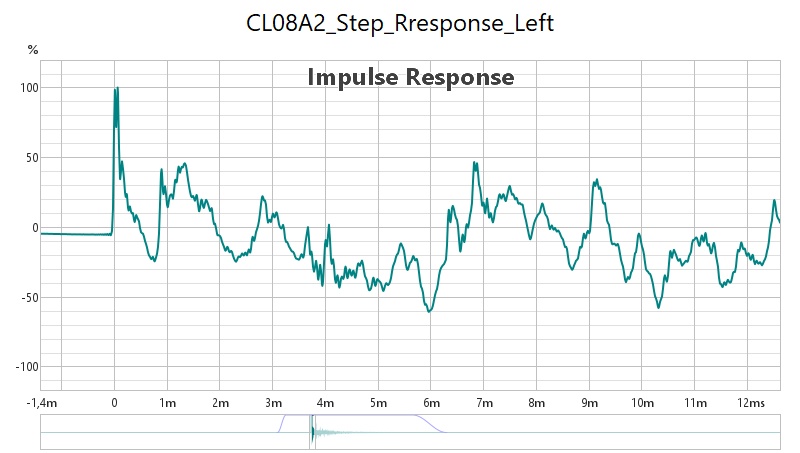 L'effetto Haas (precedenza) si manifesta quando due suoni identici arrivano all'orecchio in successione. Con ritardi superiori a 5 millisecondi con suoni semplici (click) l'udito percepisce suoni distinti. Con suoni più complessi il tempo sale a 40 millisecondi. I punti di emissione dei carichi acustici mddOmni e mddTL si trovano a distanze crescenti dal driver e i fronti sonori secondari hanno ritardi compresi fra 1 e 10 millisecondi rispetto all'emissione primaria del driver. La successione dei fronti sonori impedisce l'attivazione dell'effetto Haas, un singolo evento non può essere percepito come due suoni distinti.
L'effetto Haas (precedenza) si manifesta quando due suoni identici arrivano all'orecchio in successione. Con ritardi superiori a 5 millisecondi con suoni semplici (click) l'udito percepisce suoni distinti. Con suoni più complessi il tempo sale a 40 millisecondi. I punti di emissione dei carichi acustici mddOmni e mddTL si trovano a distanze crescenti dal driver e i fronti sonori secondari hanno ritardi compresi fra 1 e 10 millisecondi rispetto all'emissione primaria del driver. La successione dei fronti sonori impedisce l'attivazione dell'effetto Haas, un singolo evento non può essere percepito come due suoni distinti.
The Haas effect (precedence) occurs when two identical sounds arrive at the ear in succession. With delays greater than 5 milliseconds with simple sounds (clicks) the ear perceives distinct sounds. With more complex sounds the time increases to 40 milliseconds. The emission points of the mddOmni and mddTL acoustic loads are located at increasing distances from the driver and the secondary sound fronts have delays of between 1 and 10 milliseconds compared to the primary emission of the driver. The succession of sound fronts prevents the activation of the Haas effect, a single event cannot be perceived as two distinct sounds.
diffrattore acustico omnidirezionale - omnidirectional acoustic diffractor
La diffrazione acustica rende l'altoparlante omnidirezionale a tutte le frequenze. Per il principio di Huygens ogni punto di un fronte d'onda sonoro è una sorgente secondaria di onde sferiche. La fine delle guide d'onda dei carichi acustici mddOmni e mddTL sono dei punti di emissione omnidirezionali di un diffrattore acustico lineare su tutto lo spettro audio.
Acoustic diffraction makes the speaker omnidirectional at all frequencies. According to Huygens' principle, every point on a sound wave front is a secondary source of spherical waves. The end of the waveguides of the mddOmni and mddTL acoustic loads are omnidirectional emission points of a linear acoustic diffractor across the entire audio spectrum.
cabinet neutro - neutral cabinet
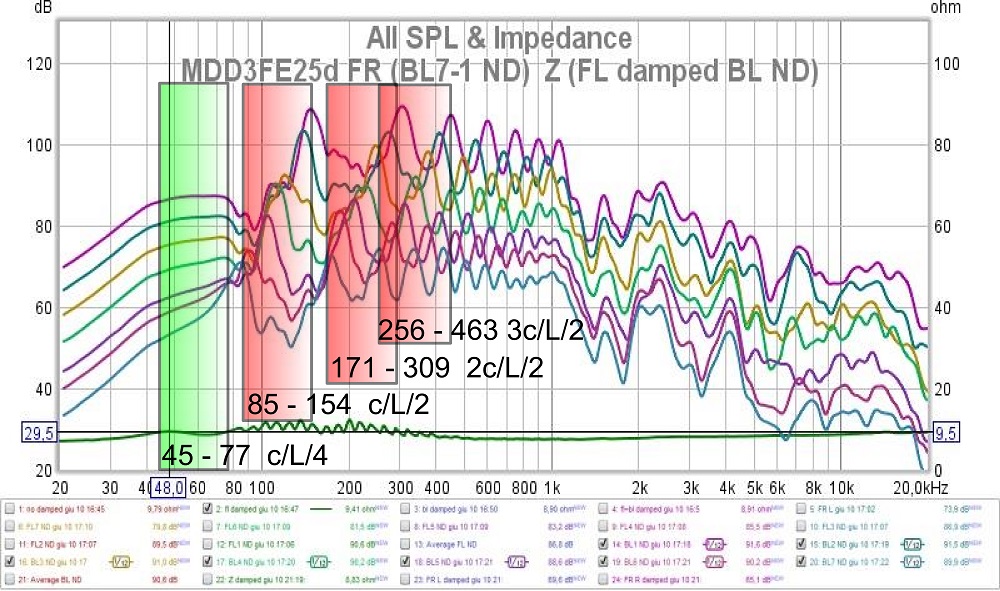 Nelle cassa acustiche TL standard si usa una guida d'onda come schermo acustico per riprodurre le basse frequenze. In generale maggiore è la lunghezza della guida maggiore è l'estensione delle basse frequenze ma si deve risolvere il problema dell'interazione con la risposta dell'altoparlante e delle pareti vicine. La progettazione del carico acustico posteriore mddTL è molto più semplice. Si usano più guide d'onda con le lunghezze calcolate con la stessa formula che determina le frequenze delle note musicali, le risonanze delle guide d'onda sono distribuite in modo omogeneo su un'ottava. Con le lunghezze in serie logaritmica la cassa acustica è neutra rispetto alla risposta in frequenza del driver e dell'ambiente d'ascolto.
Nelle cassa acustiche TL standard si usa una guida d'onda come schermo acustico per riprodurre le basse frequenze. In generale maggiore è la lunghezza della guida maggiore è l'estensione delle basse frequenze ma si deve risolvere il problema dell'interazione con la risposta dell'altoparlante e delle pareti vicine. La progettazione del carico acustico posteriore mddTL è molto più semplice. Si usano più guide d'onda con le lunghezze calcolate con la stessa formula che determina le frequenze delle note musicali, le risonanze delle guide d'onda sono distribuite in modo omogeneo su un'ottava. Con le lunghezze in serie logaritmica la cassa acustica è neutra rispetto alla risposta in frequenza del driver e dell'ambiente d'ascolto.
In standard TL speakers a waveguide is used as an acoustic screen to reproduce low frequencies. In general, the longer the guide, the greater the extension of the low frequencies, but the problem of interaction with the response of the loudspeaker and nearby walls must be resolved. The design of the mddTL rear acoustic load is much simpler. Multiple waveguides are used with the lengths calculated with the same formula that determines the frequencies of musical notes, the resonances of the waveguides are distributed homogeneously over an octave. With logarithmic series lengths the speaker is neutral with respect to the frequency response of the driver and the listening environment.
logarithmic sum
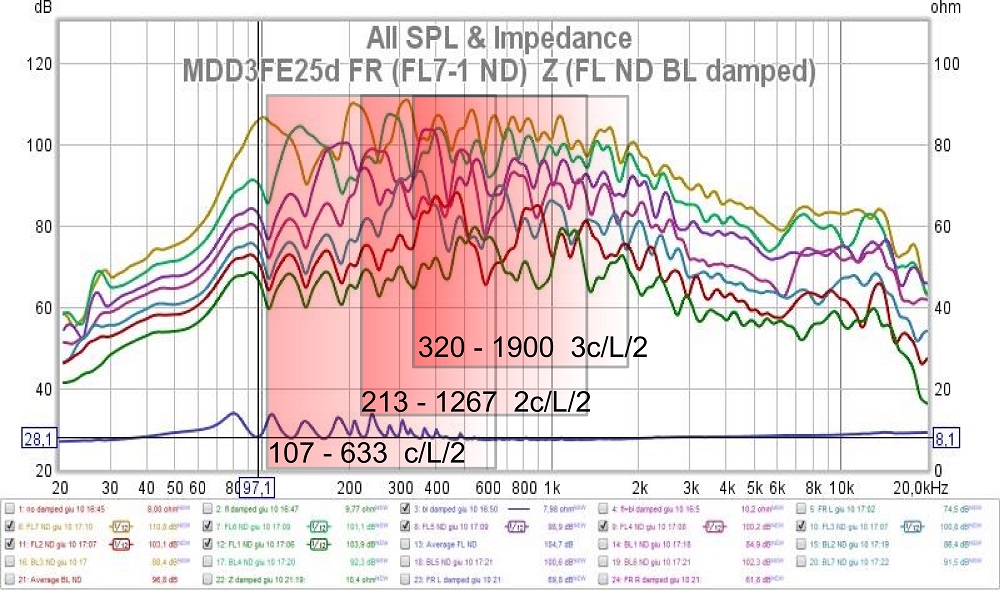 80 dB + 80 dB = 83 dB,
80 dB + 60 dB ~ 80 dB,
60 dB + 60 dB = 63 dB.
80 dB + 80 dB = 83 dB,
80 dB + 60 dB ~ 80 dB,
60 dB + 60 dB = 63 dB.

 Il carico acustico frontale mddOmni ha serie di guide d'onda di lunghezza crescente posizionate di fronte al driver. In ogni guida entra una parte dell'energia acustica emessa dal cono del driver. La stessa energia è riemessa per diffrazione acustica, in posizioni diverse, con ritardi crescenti, con un fronti d'onda sferici e coerenti con l'emissione diretta del driver. Negli ultimi prototipi le guide sono aperte a entrambi i lati con risonanze a L/2. L'emissione direzionale del driver diventa omnidirezionale.
Il carico acustico frontale mddOmni ha serie di guide d'onda di lunghezza crescente posizionate di fronte al driver. In ogni guida entra una parte dell'energia acustica emessa dal cono del driver. La stessa energia è riemessa per diffrazione acustica, in posizioni diverse, con ritardi crescenti, con un fronti d'onda sferici e coerenti con l'emissione diretta del driver. Negli ultimi prototipi le guide sono aperte a entrambi i lati con risonanze a L/2. L'emissione direzionale del driver diventa omnidirezionale.






 video
video



